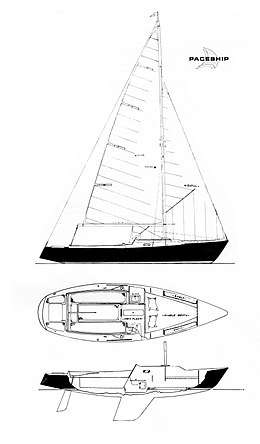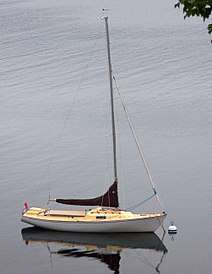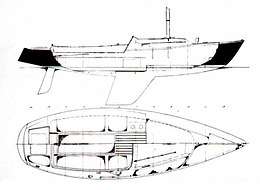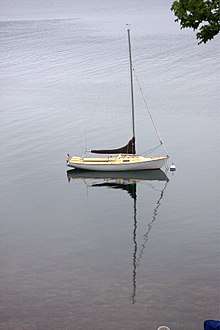Bluejacket 23
The Bluejacket 23 is a 23-foot (7.0 m) Canadian fibreglass monohull sailboat designed by Cuthbertson & Cassian (C&C Designs) as a day sailer and club racer and first built in 1967.
 MORCEE version shown | |
 | |
| Development | |
|---|---|
| Designer | Cuthbertson & Cassian (C&C Designs)[1][2][3] |
| Location | Canada |
| Year | 1967 - 1974 |
| No. built | 107[4] |
| Builder(s) | Paceship Yachts |
| Role | Daysailer or Midget Ocean Racing Club Rule (MORC) Racer |
| Boat | |
| Boat weight | 2,000 lb (907 kg) |
| Draft | 3.75 ft (1.14 m) |
| Air draft | 29.5 ft (9.0 m) |
| Hull | |
| Type | Monohull |
| Construction | Fiberglass |
| LOA | 22.83 ft (6.96 m) |
| LWL | 17.50 ft (5.33 m) |
| Beam | 7.00 ft (2.13 m) |
| Engine type | Outboard motor in well |
| Hull appendages | |
| Keel/board type | Fin keel |
| Ballast | 900 lb (408 kg) |
| Rudder(s) | Spade rudder |
| Rig | |
| General | Bermuda Fractional rig, deck stepped mast |
| I (foretriangle height) | 21.00 ft (6.40 m) |
| J (foretriangle base) | 7.50 ft (2.29 m) |
| P (mainsail luff) | 25.00 ft (7.62 m) |
| E (mainsail foot) | 9.8 ft (3.0 m) |
| Sails | |
| Sailplan | Fractional Sloop |
| Mainsail area | 78.75 sq ft (7.316 m2) |
| Jib/genoa area | 122.5 sq ft (11.38 m2) |
| Upwind sail area | 201.25 sq ft (18.697 m2) |
| Racing | |
| PHRF | 243[5] |

Production
The boat was built by Paceship Yachts in Mahone Bay, Nova Scotia, Canada. It was first offered in 1967 in the Daysailer version, with a roomy cockpit and an open cuddy (cabin). By 1970 it was also offered in the MORCEE version, a modification of the original design, which was adapted to comply with the Midget Ocean Racing Club Rule (MORC) by fitting a self-bailing cockpit and enclosing the cabin.[1][6] A total of at least 107 boats were produced (including both versions, based on known hulls) between 1967 and 1974.[1][4] It is now out of production.
Design
The Paceship Bluejacket 23 is a small recreational keelboat. It has a fractional rig, a spade rudder, and a fixed fin keel. The boat has a draft of 3.75 ft (1.14 m).[1] It displaces 2,000 lb (907 kg) and carries 900 lb (408 kg) of iron ballast.[1][3] The Bluejacket 23 has a theoretical hull speed of 5.61 kn (10.39 km/h).[7] The design of the Bluejacket 23 is very similar to several other Cuthbertson & Cassian designs built in Ontario around the same time, including the Classic 22 by Grampian Marine (which predated the Bluejacket), and the Viking 22 and later Gazelle 22 from Ontario Yachts.[1][8]

Hull and deck
The hull, deck and interior liners are integrally molded of multi-laminate fiberglass construction, built by the hand-layup method using polyester resins, 1⁄2 oz/sq yd (16.95 g/m2) mat and 24 oz/sq yd (813.7 g/m2) roving throughout the boat. Positive flotation is provided by large blocks of foam contained inside the cockpit seats and in the bow. A non-skid pattern is molded into deck and cockpit surfaces. There are two fixed lights in the cabin top for visibility and interior illumination. The deck is reinforced with plywood that is sandwiched into the laminate. All hardware is either bolted through or tapped into metal which is bonded into the laminate.[3][9][10]
Interior liner (Daysailer only)
The Daysailer interior liner is a one piece moulding. It is not integral with the deck. No self-bailing is provided in this model. It is recommended that a boom-tent be used to reduce the amount of rain water getting into the boat. A bilge pump would also be a useful extra.[10]
Interior liner (MORCEE version)
The MORCEE has a self-bailing cockpit with the cockpit an integral part of the deck. The cuddy cabin is enclosed with a hatch slide arrangement. The liner in the cabin is a separate moulding and contains two berth cushions and a sink.[10]
Keel
The fin keel is of cast iron with a double resin coating to prevent corrosion and is of a hydrodynamic design supplying maximum lift with good stability. The keel is mounted to the hull and has a separate moulded keel grid that provides greater strength in this area. The keel is attached with 3⁄4 in (19 mm) stainless steel flat head bolts, nuts and flat washers. No gasket is used to mount the keel as the mating surfaces are well matched. Keels are mounted at the factory using a silicone marine sealer between the keel and hull.[3][9][10]
Rudder
The rudder is a spade type made of fiberglass with a brass rudder stock. The rudder port is a bronze tube with bushings top and bottom. Steering is by tiller. The tiller head is cast bronze and is held on with a pin. This pin passes horizontally through the head and stock. An allen screw locks into a key in the rudder stock. The tiller is straight grained ash. The rudder can be rotated a full 360 degrees if needed.[3][10]
Deck hardware
Fully equipped for sailing, the Bluejacket 23 has deck hardware of stainless steel, Marinium and chromed brass. Fiberglass winch bases mount two No.1 snubbing winches used for headsail sheeting.[3]
Mast and boom
The anodized aluminum deck stepped mast and boom are aluminum type 6351 alloy and have integral sail slots and non-geared roller reefing.[3][10]
Standing and running rigging
Standing rigging is 1 x 19 stainless steel wire rope (breaking strength 2,100 lb (953 kg)) with swage terminals, stainless steel turnbuckles and chain plates. Running rigging is of Samson braid, including jib sheets and main sheet. Halyards are stainless steel having dacron rope tails.[3][10]
Sails
This yacht comes equipped with a 122.5 sq ft (11.38 m2) mainsail as well as a working jib as standard equipment. A No. 1 Genoa and a Spinnaker are optional.[3][9]
Outboard motor well
The lazarette contains a built in outboard well, which includes access hatch and well plug. This well is bulkheaded off from the main hull and is of the self-draining, non-filling type. There is an access door through the bulkhead for outboard operation [recommended 3 - 6 H.P. (not supplied)]. A shelf for gasoline tanks and a well plug that fairs the well opening in the hull for racing is supplied.
Like most outboard wells, it is possible to take water in under some operating conditions. The following procedure is recommended to minimize this problem:
- Remove the motor from the well when sailing. This will reduce drag and contribute to better sailing qualities.
- Install the plug insert. This will keep much of the water out of the well.
- Remove the drain plug from the forward part of the motor well box. This will allow any water to drain out. When under power, decide on conditions if the plug is best left in or out.[3][10]
Accommodations
Cabin
(MORCEE Model Only) The cabin is fully enclosed and has two fixed lights in the cabin top for visibility and interior illumination. The companionway closes with teak hatch slides. Forward a double V berth is raised a few inches above the cabin sole and is fitted with two 3" foam cushions in a choice of colours. To port, supplied as standard, is a galley unit with sink and integral water tank filled through a plug located in one corner. To starboard, provision has been made for installation of a marine head (optional). Two forward utility shelves are moulded above the berths. There is a small hatch in the cabin sole top access the bilge.[3]
Optional extra equipment
- Genoa Gear[3]
- Spinnaker Gear
- Roller Reefing
- No. 1 Top action Halyard Winch
- Marine Head installed, with seacocks
- Rally Head (chemical toilet)
- Main sheet traveller
- Anti-fouling bottom paint
- Spray Shield, Dodger
- Boom Tent
- Bow Pulpit
- Lifelines and Stanchions
- Flag Halyard
- Cushions, cabin, red, blue, beige, green
- Cockpit Cushions
- Kenyon Morcee trimmer Knotmeter (0-10 Knots)
- Henderson Bilge Pump (installed)
- Two-tone deck
Paceship Sails
- Mainsail (standard equipment)[3]
- Jib (standard equipment)
- No. 1 Genoa
- Spinnaker
Electrical system
- Running lights to International standards, interior light, switches, wiring, fuse box, battery and case.[3]
See also
Similar sailboats
- Beneteau First 235
- C&C 25
- Capri 22
- Classic 22
- COM-PAC 19
- CS 22
- DS-22
- Gazelle 22
- J/24
- Kirby 25
- Mirage 24
- Newport 20
- Nutmeg 24
- O'Day 23
- Paceship PY 23
- Ranger 22
- Rob Roy 23
- Santana 22
- Soling
- Sonic 23
- Tanzer 22
- Triton 22
- US Yachts US 22
- Viking 22
- X-79
References
- Browning, Randy (2017). "BLUEJACKET 23 (PACESHIP) sailboat specifications and details". sailboatdata.com. Retrieved 8 September 2017.
- Moran, Jay (2017). "Paceship Yachts Ltd - Bluejacket". The Paceship Website. Retrieved 8 September 2017.
- "Paceship Bluejacket Daysailer - Morcee (original sales brochure)" (PDF). The Paceship Website. 1967. Retrieved 8 September 2017.
- Moran, Jay (2017). "Paceship Yachts Ltd - boat models built". The Paceship Website. Archived from the original on 19 January 2017. Retrieved 7 September 2017.
- "Sail Nova Scotia PHRF Handicap System - List All Yachts". Sail Nova Scotia PHRF Handicap System. 2017. Retrieved 8 September 2017.
- Browning, Randy (2017). "C&C Design". sailboatdata.com. Retrieved 8 September 2017.
- InterVisionSoft LLC (2017). "Sailboat Specifications for PACESHIP - BLUEJACKET 23". Sailing Joy. Archived from the original on 8 September 2017. Retrieved 8 September 2017.
- "Classic Nova Scotia Plastic – Bluejacket 23". Canadian Yachting. 2017. Retrieved 8 September 2017.
- "Bluejacket (original sales brochure)" (PDF). The Paceship Website. 1967. Retrieved 8 September 2017.
- "Paceship Cruising Yacht - Maintenance Manual" (PDF). The Paceship Website. 1970. Retrieved 8 September 2017.
External links
